NTU scientists develop plant-based ingredient to replace eggs and dairy in mayonnaise
Sign up now: Get ST's newsletters delivered to your inbox
Follow topic:
SINGAPORE - Finicky food lovers may soon not have to skip the mayo.
Mayonnaise made entirely from plant-based ingredients - but richer in protein and antioxidants compared with the conventional product - could become a reality here.
Scientists at Nanyang Technological University (NTU) developed a plant-based emulsifier which has the necessary properties to replace egg or dairy ingredients in food staples like mayonnaise, salad dressings and whipped cream.
Emulsifiers are crucial in food production as they help to combine ingredients that usually do not mix well - such as oil and water.
For example, egg yolk is often used as the emulsifying agent in mayonnaise to ensure that the oil and water it contains do not separate.
To create the emulsifier, the NTU scientists used spent barley grains, a by-product from beer brewing and Milo production, that is rich in protein.
Professor William Chen, director of NTU's food science and technology programme who led the project, said Singapore produces around 23,000 tonnes of spent barley grains which end up in landfills. They decompose and add to the nation's greenhouse gas emissions.
Globally, 39 million tonnes of spent grains are produced by the brewing industry.
"The spent grain, though rich in protein, is not widely used in food processing as the protein component is difficult to extract," said Prof Chen.
Although the spent grains can be used for cattle feed or solid fuel, the NTU team felt that more could be done to unlock their nutritional value for human consumption.
To produce the emulsifier, the spent grain is first fermented with a fungus, known as Rhizopus oligosporus, to make the nutrient-extraction process easier.
The fungus secretes enzymes to break down the complex molecular structure of the spent grain, making it a simple and cost-effective way of extracting the proteins and antioxidants.
Current commercial processes of nutrient extraction involve the use of chemicals or high temperatures, which make them costly and complicated, said Prof Chen.
Once these proteins are extracted, they are freeze-dried into a solid form so that they can be used for producing foods such as mayonnaise.

The NTU-invented plant-based emulsifier (pictured above) is rich in protein and antioxidants, and has the necessary properties to replace eggs or dairy in food staples such as mayonnaise, salad dressings, and whipped cream.
PHOTO: NTU
The residue from the fermented grains can be upcycled to create sustainable packaging materials, noted Prof Chen.
"The idea behind this is that every part of the process truly achieves our zero-waste goal," he added.
Already, the NTU team have received interest from two companies on their plant-based emulsifiers. The first is a start-up in the plant-based food space, while the second is a household brand looking to create a novel type of sauce.
In the meantime, the team are optimising their protein-extraction methods to improve yield and quality.
"For instance, presently, for every 1kg of spent barley grains, we can only produce 100g of emulsifier. However, we aim to maximise our output to 250g, as that is the maximum amount of protein that each kg of grain contains," said Prof Chen.

Being rich in protein, the emulsifier could be beneficial for the growth of the plant-based meat industry, he added.
"Some consumers have felt that the level of protein content is too low compared to animal meat, while others said that the taste is not yet up to par," said Prof Chen.
The emulsifier could not only boost the protein content in plant-based meat, but its taste - which resembles that of Marmite - could also improve the flavour, he added.
Marmite is a savoury food spread made from yeast extract.
Due to the emulsifier's spreadable properties, the team also hope to explore pharmaceutical and cosmetic uses in products such as topical creams, lipsticks and more.
Nutritional information for NTU’s plant-based mayonnaise
Compared with store-bought mayonnaise, NTU’s plant-based version has a slightly higher calorie content due to greater amounts of protein and essential amino acids.
- Calorie content: 702kcal per 100g versus 680kcal per 100g for conventional mayo
- Protein: 6.6g per 100g versus 0.9g per 100g for conventional mayo
- The sugar and saturated fat content is similar for both types of mayo
Taste: (4.5/5)
- The plant-based mayo has a more distinct flavour compared with the conventional type, and has a slightly yeasty taste.
Resemblance to conventional mayo: (4/5)
- The plant-based mayo is slightly pale orange in colour with a smoother texture, whereas the conventional product has a light cream colour and a fluffier texture.
Using the spent barley grains for packaging material
Aside from turning the spent barley grains into plant-based emulsifiers, the residue from the fermentation process can be made into sustainable packaging materials, as it is fibre-rich and biodegradable.
The residue is placed in a mould to create shapes, such as disposable cups that have a thick, paper-like texture, said Professor William Chen, director of NTU's food science and technology programme.
The innovation has been licensed to a local start-up, and work is under way to create a replacement material for disposable plastic containers meant for carrying or storing food.
While Prof Chen's team is working on perfecting the packaging material - such as by making it waterproof, the company is looking at scaling up the production of these containers, he added.
Aside from spent barley grains, other types of sustainable packaging can be made from fermenting fruit peels and okara, or soya pulp.
The fermentation process helps to concentrate the fibre and cellulose from these waste products, giving the packaging materials their sturdy texture.

